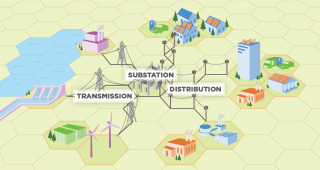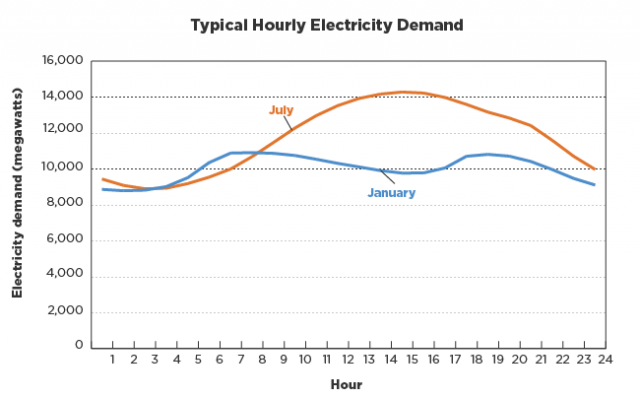Electricity Delivery and its Environmental Impacts

- About electricity delivery
- Electricity delivery in the United States
- Environmental impacts of electricity delivery
About Electricity Delivery
After a centralized power plant generates electricity, the electricity must be delivered to the end-user. This delivery happens in three steps:
- Transmission. Centralized power plants produce high-voltage electricity to facilitate the transmission of the electricity over long distances and lessen the amount of electricity lost to friction in the wires. High-voltage transmission lines typically carry the electricity to a substation.
- Substation. Substations are used to condition electricity as it moves through the grid. Substations can include switching, protection, and control equipment; capacitors; voltage regulators; and transformers. Substations can either “step down” or “step up” high- or low-voltage electricity to prepare it for further transmission or distribution.
- Distribution. The distribution portion of the electric grid comprises lower voltage power lines that deliver electricity to end-users. Distribution networks tend to span shorter distances and involve delivery of electricity that has voltages common to end-user needs (e.g., 120 volts for a typical home).
Utilities and other grid operators work together to generate and deliver electricity where and when it is needed. For the most part, electricity needs to be generated when it will be used. These needs fluctuate depending on the day, the time, and the weather. The graph below shows variations in the amount of electricity that customers used per hour over a typical week in the summer and a typical week in the winter.
Generation capacity availability can also fluctuate. For example, the amount of sunlight that can be captured by solar photovoltaic panels and converted to electricity depends on the weather (sunny or cloudy) and the angle of incoming sunlight (which depends on the season and time of day).
Utilities and grid operators need to ensure that enough power will be generated to meet demand when it is high. Baseload power plants generate electricity in most hours of the year and often cannot be turned off or restarted easily. If consumers demand more electricity than baseload power plants can provide, operators respond by increasing production from centralized generation facilities that are already operating at a lower level or on standby, importing electricity from distant sources, or calling on end-users who agreed to consume less electricity from the grid through demand response programs. Improving the ability to balance electricity demand and supply is one reason investments are being made in energy storage and modernizing the electricity grid.
Electricity Delivery in the United States
In the second half of the 20th century, utilities began to interconnect their transmission systems to distribute electricity over longer distances from larger, more centralized power plants. This system has grown to include thousands of miles of transmission lines and millions of miles of distribution lines.
While a single utility might build and maintain transmission and distribution lines, these lines are often shared by several utilities and electricity retailers. In some areas, regional organizations known as independent system operators (ISOs) or regional transmission organizations (RTOs), made up of utilities and federal and state regulators, coordinate transmission and distribution across their region. In areas without an established ISO or RTO, delivery systems are operated by individual utilities. To learn more about ISOs and RTOs, visit the Federal Energy Regulatory Commission’s website.
Environmental Impacts of Electricity Delivery
While the most significant environmental impacts of electricity relate to how it is generated, electricity delivery can also affect the environment in several ways:
- Transmission and distribution lead to some losses in electricity as it moves from the point of generation to the end-user. These losses are collectively referred to as “line loss.” In general, the longer the distance the electricity must travel from generation to consumer, the larger the line loss.
- Power lines require routine maintenance and operation. Trees and other plants near the wires have to be maintained to keep them from touching the wires. On some power line corridors, herbicides are used to control vegetation.
- When power lines and their access roads are placed in undeveloped areas, they can disturb forests, wetlands, and other natural areas.
Many high-voltage circuit breakers, switches, and other pieces of equipment used in the transmission and distribution system are insulated with sulfur hexafluoride, which is a potent greenhouse gas. This gas can leak into the atmosphere from aging equipment or during maintenance and servicing. Learn more about sulfur hexafluoride in electric power systems.

